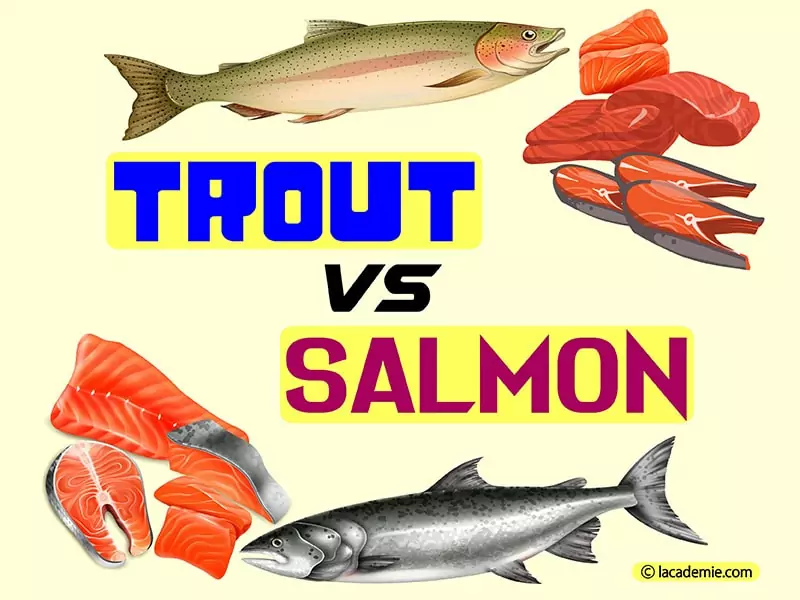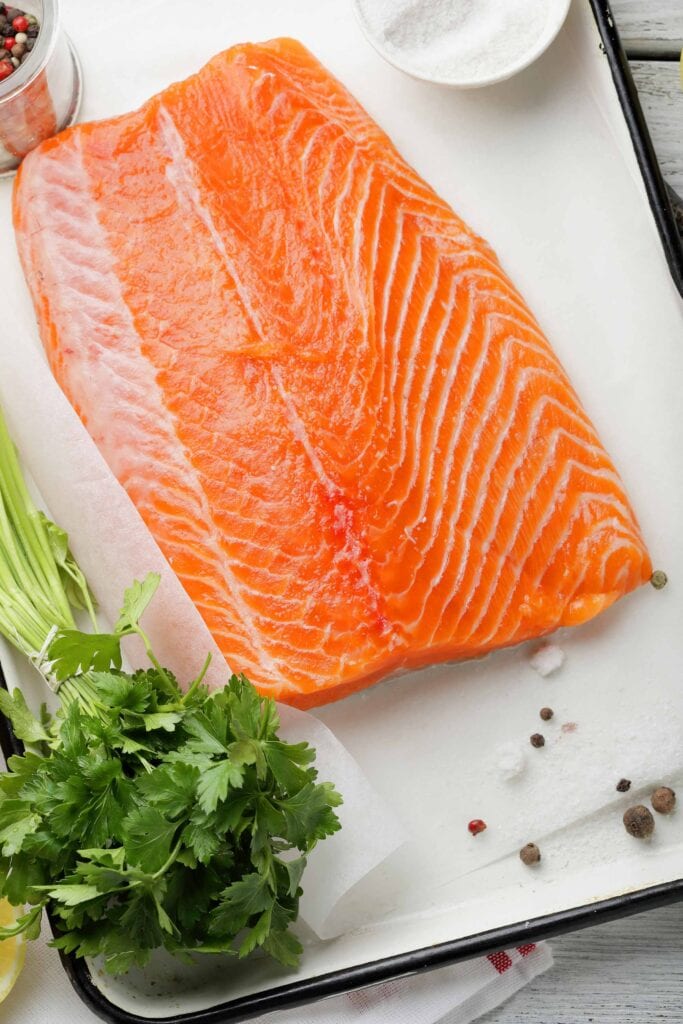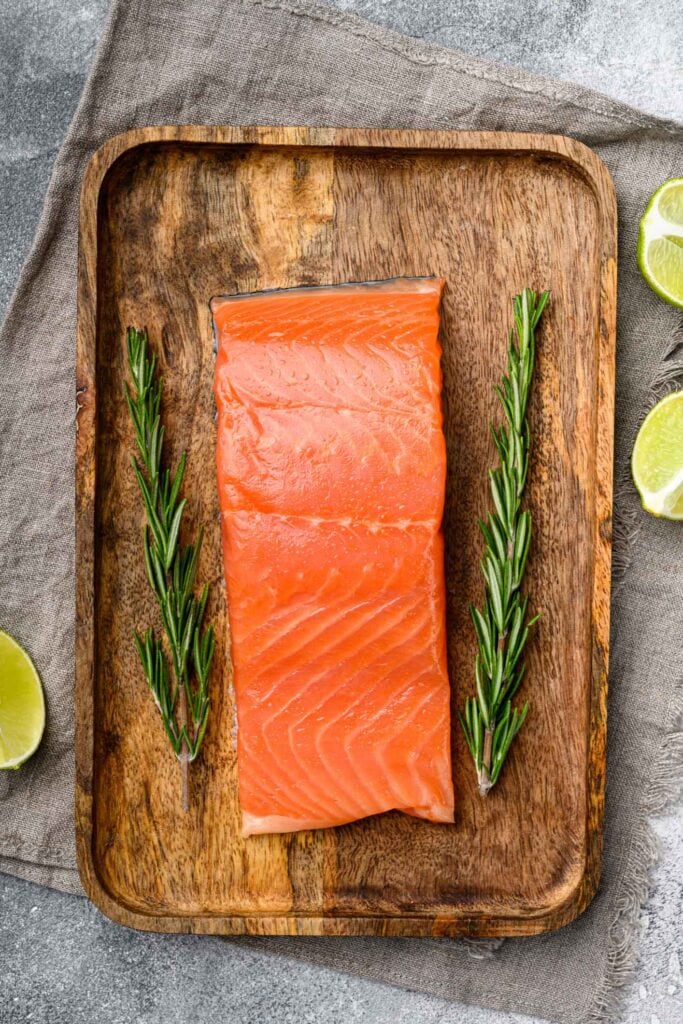Do you want to know what the main differences are between trout and salmon? This helpful guide goes into that, plus it has cooking tips, wine and food pairings, and what to look for when you’re shopping for fish.
In the seafood business, salmon and trout are two of the most popular fish. Anglers love to fish for them, and foodies adore eating them. Is trout better than salmon when it comes to taste, texture, nutrition, and other things?
I’ve been fishing for both trout and salmon for over 20 years. In my experience, there’s no definitive answer to which fish tastes better. It really comes down to personal preference. But there are some important differences between salmon and trout that you should think about.
Appearance and Physical Characteristics
At a glance, trout and salmon look quite similar. Their bodies are both sleek and torpedo-shaped, with fins, gills, and tails that help them swim quickly. But when you look closer, there are some clear visual differences:
- Size: Salmon are generally much larger, growing up to 5 feet long. Trout are typically smaller, less than 3 feet.
- Skin: Salmon have silver, metallic-looking skin while trout have more colorful spots and patterns on their skin.
- Tail: Salmon have forked tails and trout have square-shaped tails.
These physical differences reflect the fact that salmon spend part of their lifecycle at sea while trout stay in freshwater their whole lives, The larger size and ocean-adapted features of salmon equip them for migrating long distances,
Habitat and Life Cycle
Salmon and trout need different habitats and go through different life cycles
-
Trout spend their entire lives in freshwater lakes, rivers, and streams. They spawn by laying eggs in gravel beds in the water.
-
Salmon hatch in freshwater but then migrate to the ocean to feed and grow for 1-5 years before returning to freshwater to spawn.
This anadromous life cycle that salmon go through allows them to grow much bigger than resident freshwater trout. It also gives salmon a more complex flavor profile since they get nutrition from both marine and freshwater food sources.
Fishing Methods
To catch trout, anglers use fly fishing, lures, and bait in flowing streams and lakes. Trout prefer cold, clear water and are easy to catch.
Salmon require more heavy duty ocean fishing methods like trolling and nets to land them. But in rivers, salmon can still be caught by casting flies and lures. Their sea-run life makes them a prized game fish.
So trout fishing tends to be more accessible but landing big salmon provides anglers with a greater challenge and sense of accomplishment.
Culinary Uses
The texture and fat content of salmon and trout lend themselves to different cooking methods:
-
Trout have a delicate flavor and flaky texture. They are best prepared simply with baking, pan-frying or smoking to preserve their mild taste.
-
Salmon have a robust, fatty flavor that stands up well to grilling, broiling, poaching, and marinades with bold flavors. Their firm texture makes them suitable for sushi as well.
In essence, trout shine when cooked gently while salmon can handle more intense heat and flavorings.
Nutrition
Both salmon and trout are nutritious:
-
Trout have about 140 calories and 23g protein per 3 ounce serving. They are high in B vitamins and potassium.
-
Salmon pack about 180 calories and 25g protein per 3 ounce serving. They excel in omega-3 fatty acids which support heart and brain health.
So while trout wins for lower overall calorie count, salmon contains more of those all-important omega-3s thanks to dining on omega-3 rich krill and fish at sea.
Taste and Texture
Now for the most important factors – taste and texture:
-
Trout has a subtle, mild flavor with a slightly nutty essence. The flesh ranges from pink to orange with a tender, moist texture.
-
Salmon has a richer, more pronounced salmon-y flavor with a smooth, fatty mouthfeel. It ranges from pink to deep red in color.
Other than these visual differences, you can notice the distinctions between salmon and trout in terms of their texture and taste. Salmon meat tends to carry much more fat which gives it a richer and stronger flavor. Meanwhile, trout is also known to be rich and luscious, albeit carrying a lighter and fresher taste.
Price Differences
There’s usually a noticeable price difference when comparing salmon vs. trout:
-
Trout costs $7-15 per pound on average for whole fish or fillets. More common.
-
Salmon can cost $15-25+ per pound, especially for wild-caught sockeye or king salmon. More scarce.
The cost reflects the high demand and limited supply of wild ocean salmon compared to large hatchery trout harvests.
Final Verdict: It Depends on Taste Preferences!
So when you’re deciding whether trout or salmon taste better, there’s no right or wrong answer. Here are some key factors to consider:
Trout pros: Mild flavor, tender texture, widely available, lower cost
Salmon pros: Rich fatty flavor, silky mouthfeel, omega-3 content
Trout cons: Less omega-3s, smaller size, less prestige
Salmon cons: Potentially fishier taste, higher cost, rarer availability
My personal favorite is salmon because I enjoy the complex flavor and buttery texture. But I know many anglers who prefer the lighter taste and texture of trout.
At the end of the day, it all comes down to your taste buds. Hopefully this comparison helps break down the nuances between trout and salmon so you can decide which fish fits your preferences better. The most important tip is to try them both regularly and continue challenging your palette!

Tips for cooking with trout
Trout is a seafood that’s easy to prepare for quick family dinners or healthy lunches. It’s delicate though, so use these cooking tips before you get started:
- Don’t cook the fish right away? Put it in the fridge for up to two days.
- Keep the seasonings simple. To make the trout shine, all you need is butter, lemon juice, garlic, salt, pepper, or fresh parsley.
- A light coating of flour on trout before cooking it in oil also makes it taste great.
- You can bake, pan sear, braise, or grill both the filet and the whole fish.

Most fish recipes pair particularly well with crisp white wines, and trout is no exception:
- It goes great with a glass of Sauvignon Blanc or Riesling because the flavors are light and mild.
What goes well with trout?
Stick to light and fresh sides to bring out the trout’s beautiful flavor, such as:
Most salmon live in the ocean and only return to freshwater to spawn and mate. From sockeye salmon to Atlantic salmon to chinook salmon, there are many types of salmon that people in North America like.
They’re closely related to trout but have significant differences:
- There are spots all over the fins and backs of almost every type of salmon. Most are silver, but when it’s time to breed, they turn brown, red, and pink.
- They have very long and slender bodies.
- When you cut into salmon, the bright red or pink flesh makes it stand out from the rest.
- Salmon is light and buttery all on its own. You barely need to add any seasonings!.
- The filets are also tender, flaky, meaty, and rich.
- Salmon has different tastes depending on how it’s cooked, but in general it’s very mild.

Difference between Salmon and Trout Video June 2022 (Updated)
FAQ
Which is healthier salmon or trout?
Is trout a high quality fish?
Is trout cheaper than salmon?
Does trout taste good?
Is trout healthier than salmon?
Salmon is an oilier fish, being higher in calories and fats, including saturated and unsaturated fats. Salmon also provides 3 times more vitamin B9 and 2 times more vitamins B1 and B6. However, trout is richer in protein and higher in cholesterol. Trout is also a better source of most minerals, such as calcium, zinc, and potassium.
Which is better, salmon or tuna?
Wild salmon is healthier, but it is also harder to find and more expensive. But if we compare farmed salmon with wild tuna, tuna wins.
Does salmon taste better than trout?
Some Salmon taste better than some Trout and vice versa. Here are the most common species for sale in North America, and how they compare as food. Most of the Trout for sale in North America is Rainbow Trout. The pinkish meat is mild and delicate, and they’re generally the perfect serving size for one per person.
What is the difference between trout and salmon?
While trout and salmon may look and taste similar they are distinct species of fish. The major difference between the two is that Trout is a freshwater fish, and Salmon is a saltwater fish. Salmon typically has a higher fat content than trout and is almost always larger in size. Trout has always been the fish that people have loved to catch.
